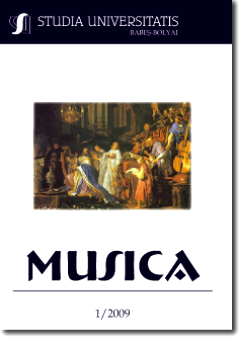THE ROLE OF THE POPULAR TRADITION IN THE DEVELOPMENT OF MELODIES WITHIN THE SONGS OF TRANSYLVANIAN REFORMED COMMUNITIES
Keywords:
Ornaments, appoggiatura, melismatic group, variation, rhythm, cadence, tonalityAbstract
The framework of the church song melodies have merely been transcribed in the old written or printed documents. In order to create a complete, realistic image it is necessary to do a thorough research and compare the written documents with the oral folklore. The church songs that are present and live in the folklore had undergone some changes due to the oral tradition. The performance of the popular singer can be usually characterized to a certain degree by the melodic ornamentation. The embellishments do not affect the melodic line, for they provide a specific feature to the performance. The melodic change is insignificant if only some melodic idioms are modified. In addition, there can be examples of total variations. In some cases the changes are so significant than even the stanza structure is modified. Sometimes cadences change, a process that could alter the inner cadences as well as the cadences placed at the end of the verse. In this instance a modal variation occurs. A modal change is created also in case the final melodic line that determines the mode of a song is lost. In the following examples we will also present melodic augmentations. These augmentations are always external ones, partially through repetition, partially through the introduction of new elements. We suspect that the motivation underneath creating different variations of the same melody is a psychological one. Still, bad memory or individual taste could have dictated the making of spontaneous or unconscious changes within a melody. However, the performer could consciously strive to modify, innovate the already existing structures. The melodies modified in the slightest degree were those that have been continuously present in the hymnbooks and were always a part of a liturgy. Nevertheless, the melodies that were pushed out from the hymnbook collections throughout the centuries have undergone some considerable changes.
References
Bartha, Dénes, A XVIII század dallamai, (Melodies of the 18th Century) MTA, Budapest, 1935.
Bartók, Béla, A magyar népdal (Hungarian folk music), in: Bartók Béla összegyűjtött írásai (Collected writings of Bartók Béla), Edited by Szőllősy András, Zeneműkiadó, Budapest, 1966.
Bartók, Béla, Romanian Folk Music II.,Vocal Melodies, Ed. B.Suchoff, Den Haag, 1967.
Dobszay, László, Szendrei Janka, A magyar népdaltípusok katalógusa (The Hungarian Folk Song Type Catalogue,) IV, Kiadja a MTA Zenetudományi Intézete (edited by Science of Music Department of the Hungarian Academy of Sciences), Budapest, 1988.
Kodály, Zoltán, A magyar népzene (Hungarian Folk Music), Zeneműkiadó, Budapest, 1973.
Kodály, Zoltán, Néprajz és zenetörténet (Ethnology and Music History), 1933, in: Visszatekintés (Retrospection) II, Zeneműkiadó, Budapest, 1974.
Paksa, Katalin, A magyar népdal díszítése (The Ornaments of Hungarian Folk Music), Magyar Tudományos Akadémia Zenetudományi Intézete, Budapest, 1993.
Papp, Géza, Régi Magyar Dallamok Tára II, A XVII. század énekelt magyar dallamai (Old Hungarian Melodic Repository, Sung Melodies of the 17th Century) Akadémiai Kiadó, Budapest, 1970.
Szabolcsi, Bence, A magyar zenetörténet kézikönyve (Hungarian Music History Handbook), Zeneműkiadó, Budapest, 1955.
Szendrei, Janka – Dobszay, László – Rajeczky, Benjámin, XVI–XVII. századi dallamaink a népi emlékezetben Our 16th and 17th Songs in the Popular Melody II, Akadémiai Kiadó, Budapest, 1979
Vargyas, Lajos, A magyarság népzenéje (Hungarian People’s Folk Music), Zeneműkiadó, Budapest, 1981.
Downloads
Published
How to Cite
Issue
Section
License
Copyright (c) 2009 Studia Universitatis Babeș-Bolyai Musica

This work is licensed under a Creative Commons Attribution-NonCommercial-NoDerivatives 4.0 International License.



